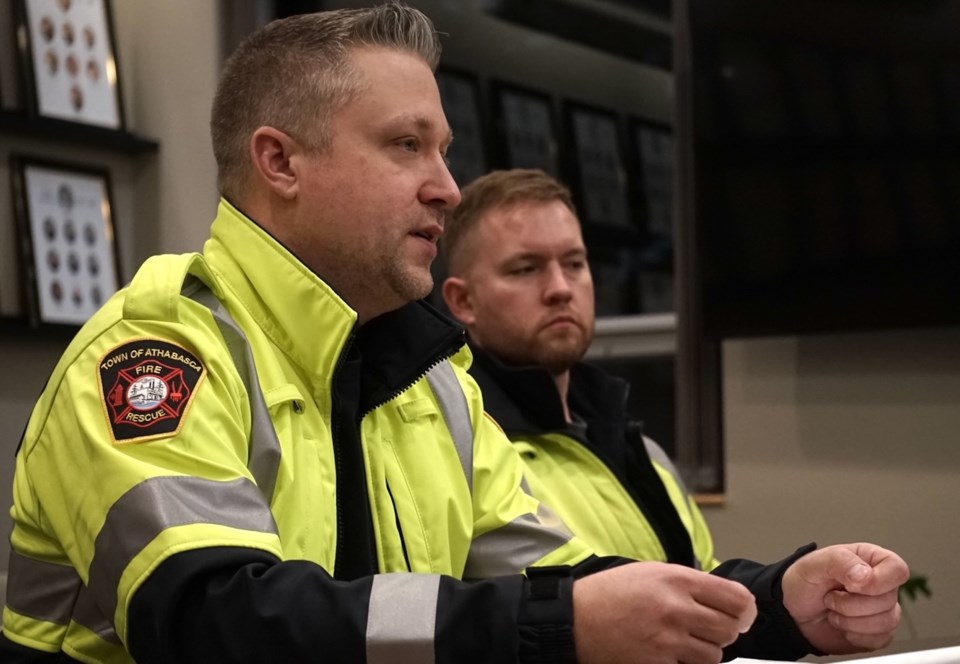ATHABASCA — 2024 proved an eventful year for firefighters across Alberta, and the volunteers at the Athabasca Fire Department were no exception in a year that saw the largest fire in Jasper National Park’s history and the destruction of a local landmark.
Athabasca Fire Chief Jason Sturrock and assistant chief John Burton attended the Feb. 4 town council meeting clad in their black and yellow reflective winter jackets to give councillors the department’s year-end report, reflect on the major events, and look ahead to 2025.
“The Union Hotel fire was a big fire, big learning for us. Great job by all of our members,” said Sturrock. “And then we were able to deploy a unit to Jasper so we sent some guys down there, and the Village of Boyle helped us out with numbers there, too.”
“Calls were down 15 calls from the year prior,” said Sturrock. The 24 community members who make up the department responded to 36 alarm calls in 2024, more than in both 2023 and 2022, but members saw the frequency of vehicle fires decline again this year, down to 4 in 2024 compared to 6 in 2023 and 16 in 2022.
Medical calls remain the department’s most common requests for service; members responded to 46 medical calls in 2024, and while that’s three less than in 2023, only one call was received in 2022.
One of the department’s engines cost the firehouse more than expected when it failed a performance test and needed a replacement pump, an expense Sturrock said can hopefully be mitigated by proper precaution.
“This was attributed to lots of sand in the pump, so we figured when we’re down at the riverfront and we’re drafting and doing our training and stuff sand was getting in, so we came up with some measures to mitigate that.”
For the upcoming year, the department plans to replace two of its older pick-up trucks with one newer unit, equipped with a skid unit — pump, hose, and controls — for wildland calls. With the new unit, the department will have two wildland fire vehicles ready to handle the growing number of wildfire calls in the area.
In 2024, members responded to 19 wildfire calls, down from the 21 seen in 2023, but still trending upwards of the five seen in 2022. In addition to ice rescue training, the department will be focusing on better preparing to handle wildland calls based on the provincial government’s Wildland Urban Interface Guidelines.
“There’s a lot more labour in wildland firefighting, a lot more getting in front of the fire,” said Sturrock. “When you’re in a structure, you’re limited on fuel so you just concentrate on that fuel, but in a wildland fire your fuel is vast.”
Sturrock said better knowledge and skills like how to safely fell trees in forested areas and identify hidden fuel hazards like peat moss pits is needed in the face of rising wildland calls.
One item at the top of the department’s equipment wish list is a sprinkler unit trailer that would allow simultaneous coverage of multiple residences at once. Although it would be a major boon to the department, the trailer comes with a $250,000 price tag, a total the Friends of the Athabasca Fire and Rescue Society are working on fundraising.
Coun. Dave Pacholok had lots of questions for the duo, with many focused around manpower and the turnover rate of recruits. While Sturrock and Burton said the team has a healthy roster, they always welcome more bodies, and can find a spot for all skill and ability levels.
“You get people that come into it and they don’t really know what to expect, sometimes some of the stuff we do can be a little bit scary for some people,” said Burton.
“It’s not all running into fires; we can find a position for anybody that wants to volunteer. On a structure fire, we need rehab — we need people there for the firefighters coming out to switch their bottles over, make sure they’re hydrated, we need a safety officer on board keeping track of who’s in the building and who’s coming out.”
“So there’s still potential,” said a hopeful Pacholok.



